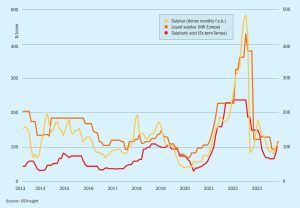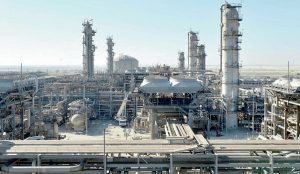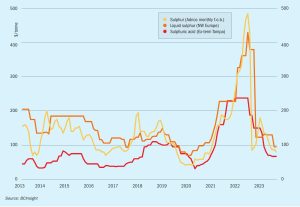
Price Indications
Market Intelligence Price Indications Table 1: Recent sulphur prices, major markets

Market Intelligence Price Indications Table 1: Recent sulphur prices, major markets

A report on CRU’s annual Sulphur + Sulphuric Acid conference, held in New Orleans, USA, 6-8 November 2023.

Tecnimont, part of MAIRE’s Integrated E&C Solutions business unit, has signed a letter of award with ADNOC for the onshore processing plant of the Hail and Ghasha Development Project. The award was signed at ADIPEC, the world’s largest energy summit. The project aims to operate with net zero CO 2 emissions, in part due to the facility’s CO 2 carbon capture and recovery units, which will allow the capture and storage of CO 2 . The project will capture 1.5 million t/a of CO 2 , taking ADNOC’s committed carbon capture capacity to almost 4 million t/a. The company recently announced its decision to double its carbon capture capacity to 10 million t/a by 2030. The Hail and Ghasha CO 2 will be captured, transported onshore and stored underground, while low-carbon hydrogen will be produced to replace fuel gas and further reduce emissions, according to ADNOC. The project will also use power from nuclear power plants and renewable sources from the grid.

A softer trend in DAP prices, linked to lower operating rates in China and declining demand, is contributing to falling sulphur prices.

Following the completion of expansion work on the ultra-sour gas Shah field in May 2023, production has been ramped up. Occidental, which owns 40% of the Shah project and which operates the field in conjunction with ADONC Sour Gas, reported in July that it had achieved record output at Shah, with gross gas sales reaching 722 million scfd in Q2 2023 (equivalent to 1.1 billion scf/d of raw gas, which is 23% H2S and 10% CO 2 ). The expansion has taken processing capacity at Shah to 1.45 billion scf/d and forms part of the UAE’s plans to achieve gas self-sufficiency by the end of the decade. The expansion was conducted by Saipem, who were awarded a $510 million contract in 2021 to expand output from 1.3 billion scf/d to the current 1.45 billion scf/d. Work was completed two months ahead of schedule, according to Occidental.

New supply is weighing on the market. In addition to increased exports in the second half of the year from upgrades and new refining projects from the Middle East, crushed lump sulphur is also again entering the market in higher quantities from both the FSU and the Middle East, and displacing granular product in some markets, notably Morocco and China.

Maria Mosquera, Editor of the Argus Sulphur Report and Liliana Minton, Editor of the Argus Sulphuric Acid Report at Argus Media assess price trends and the market outlook for sulphur and sulphuric acid.

Lithium ion battery production is driving major expansions in nickel and cobalt extraction, but lithium iron phosphate (LFP) battery use is growing rapidly.

All is not well with the Chinese economy. Growth has slowed to a fraction of what it was, only 0.8% in 2Q 2023, and has not bounced back as expected as covid lockdowns were eased. Exports and imports are both falling, debt has reached 300% of GDP, youth unemployment is running at 20%, and the property market is collapsing, with huge property developers like Evergrande and Country Garden only avoiding bankruptcy via government arranged loan restructurings. Consumer prices have fallen year on year, raising the spectre of deflation, and productivity growth has fallen from 4.5% year on year in 2006-7 to around 0.8% today. The yuan is trading at a 16-year low against the dollar.

While phosphate fertilizer production represents the main slice of demand for elemental sulphur and sulphuric acid, sulphur fertilizers continue to be a growing sector of demand due to changes in the way that we use sulphur.